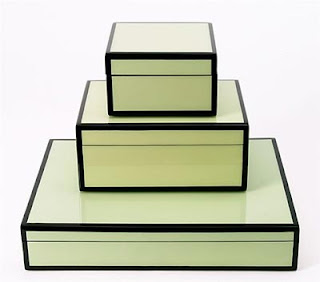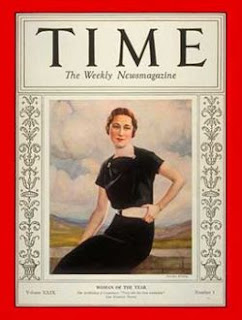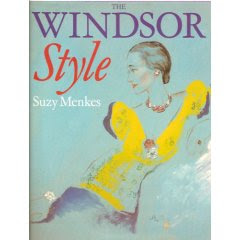
Now, I am not renovating my house, and I only have one bathroom, so I am not sure what I am going to do with a new-in-box sink.





 The Peak of Chic had an article about the interior designer Billy Baldwin the other week and we got to thinking about some other notable Baltimoreans. Another style-maker of Baldwin's same time period was the Duchess of Windsor, former Baltimorean, Wallis Warfield Spencer Simpson Windsor.
The Peak of Chic had an article about the interior designer Billy Baldwin the other week and we got to thinking about some other notable Baltimoreans. Another style-maker of Baldwin's same time period was the Duchess of Windsor, former Baltimorean, Wallis Warfield Spencer Simpson Windsor.  In 1998, the contents of her house outside of Paris, which were owned by Mohammad Al Fayed, owner of Harrods in London and father of Dodi Fayed, who was killed in the accident with Princess Diana, were auctioned by Sotheby's for more than $23 million.
In 1998, the contents of her house outside of Paris, which were owned by Mohammad Al Fayed, owner of Harrods in London and father of Dodi Fayed, who was killed in the accident with Princess Diana, were auctioned by Sotheby's for more than $23 million.







Lulu's website is lots of fun with the requisite catalogue of her goods, and they're great, and some gossipy pages, her fashion blog, her ad campaigns - the most recent of which is a take-off on Alice in Wonderland, and is quite clever.

When my buddy, Miss M.A. came to stay with me in London, I gave her photos of the trip in Lulu's adorable and appropriate photo album, illustrated with embroidered scenes of London. So put on your pearls, check out Lulu's website and have some fun!
So put on your pearls, check out Lulu's website and have some fun!
Update 3.27: I just saw Lulu's book on Horschow Collection for $150!!! What's that all about?
 Growing up in Baltimore, we always had Stieff silver on our table. Stieff and Samuel Kirk & Sons, a firm established in the early 1800's, merged in the 1970's to become Kirk-Stieff. Both firms are closely associated with Baltimore, but were acquired by Lenox in the late 1990's and no longer exist.
Growing up in Baltimore, we always had Stieff silver on our table. Stieff and Samuel Kirk & Sons, a firm established in the early 1800's, merged in the 1970's to become Kirk-Stieff. Both firms are closely associated with Baltimore, but were acquired by Lenox in the late 1990's and no longer exist.  My mother has an extensive collection of both Kirk and Stieff silver. Her maiden name is Rose, so her pattern was Stieff Rose. Kirk Rose is the Repousse pattern. Throughout the years, she has collected a wide assortment of silver pieces, from ice cream forks to punch ladles. When it came time for me to select a pattern, I chose the family pattern.
My mother has an extensive collection of both Kirk and Stieff silver. Her maiden name is Rose, so her pattern was Stieff Rose. Kirk Rose is the Repousse pattern. Throughout the years, she has collected a wide assortment of silver pieces, from ice cream forks to punch ladles. When it came time for me to select a pattern, I chose the family pattern. 
 When I returned from the UK, I wanted something new again, so bought a pattern from Target! It's called Solar and is "silver" with embossed dots. Very simple, very easy. When I get bored with it, I won't feel bad about replacing it.
When I returned from the UK, I wanted something new again, so bought a pattern from Target! It's called Solar and is "silver" with embossed dots. Very simple, very easy. When I get bored with it, I won't feel bad about replacing it. 
 Last night, while billions of Chinese were celebrating the Year of the Pig, so were a group of friends and I. The hostess has been collecting pigs throughout her entire life, so she had plenty to choose from for the table decorations. After a blind tasting of several wines, I amused myself at dinner arranging her napkin rings and photographing them.
Last night, while billions of Chinese were celebrating the Year of the Pig, so were a group of friends and I. The hostess has been collecting pigs throughout her entire life, so she had plenty to choose from for the table decorations. After a blind tasting of several wines, I amused myself at dinner arranging her napkin rings and photographing them. 


 In my post, London Calling, I talked about Tricia Guild's stores on the King's Road in London. Yesterday, the New York Times did a slideshow feature about some of her new line of wall coverings which were shown at the Maison et Objet show in Paris. There were also some other wonderful items from the show, including ultra luxe curtains in silk and seed pearls.
In my post, London Calling, I talked about Tricia Guild's stores on the King's Road in London. Yesterday, the New York Times did a slideshow feature about some of her new line of wall coverings which were shown at the Maison et Objet show in Paris. There were also some other wonderful items from the show, including ultra luxe curtains in silk and seed pearls. 
 One of the other designers who is featured in this slideshow is William Yeoward, who works out of a shop which is also in King's Road in London. On his website you can find a beautiful PDF booklet of his designs, entitled Seduction.
One of the other designers who is featured in this slideshow is William Yeoward, who works out of a shop which is also in King's Road in London. On his website you can find a beautiful PDF booklet of his designs, entitled Seduction. 



 A few weeks ago, I told you about the Mount Clare Mansion, a five-part Georgian mansion in downtown Baltimore. The Mansion will be hosting a landmark exhibition in May 2007. Wedgwood items will be shown in the rooms in the settings which they would have originally appeared (had the family owned some Wedgwood - which they didn't, oddly). Pieces will be placed in the cabinets and on the tables, shown in a natural setting.
A few weeks ago, I told you about the Mount Clare Mansion, a five-part Georgian mansion in downtown Baltimore. The Mansion will be hosting a landmark exhibition in May 2007. Wedgwood items will be shown in the rooms in the settings which they would have originally appeared (had the family owned some Wedgwood - which they didn't, oddly). Pieces will be placed in the cabinets and on the tables, shown in a natural setting.One of the signature pieces which will be on exhibit will be the jasperware Portland Vase used in the Wedgwood logo. Additionally, there will be yellow, green, black, lilac and red jasperware pieces on display. The exhibition is being held in conjunction with the International Wedgwood Society which is meeting in Baltimore in May.

Vera Wang Imperial Scroll
Barbara Barry Musical Chairs
Although Wedgwood is 300+ years old, they keep up to date, while maintaining a selection of their classic pieces. Most people think of Wedgwood as only their Jasperware, with the blue background and white figures and their black basalt vases and urns. But among their collection designers are Vera Wang, Jasper Conran and Barbara Barry.

 One of the new collections is a bold new take on the historic and ubiquitous Blue Willow Pattern. Robert Dawson has taken this pattern and blown it up by a significant percentage. Slices of willow-ware edge his plates, cups and bowls.
One of the new collections is a bold new take on the historic and ubiquitous Blue Willow Pattern. Robert Dawson has taken this pattern and blown it up by a significant percentage. Slices of willow-ware edge his plates, cups and bowls.
One of the reasons that Wedgwood has been a market and style leader for more than 300 years is that they know how to change with the time. If you're interested in the Three Centuries of Wedgwood Exhibit, check the Mount Clare website.
 Well, I am not much for Valentine's Day this year, as I don't expect to get anything from Connor! But there are some very nice presents I would like to get (actually, I don't really want anything - I am still gun-shy after my robbery in December). Here are some things I would not object to getting in my Valentine's Day stocking.
Well, I am not much for Valentine's Day this year, as I don't expect to get anything from Connor! But there are some very nice presents I would like to get (actually, I don't really want anything - I am still gun-shy after my robbery in December). Here are some things I would not object to getting in my Valentine's Day stocking.  Probably not in this or any other lifetime! But a girl can wish...
Probably not in this or any other lifetime! But a girl can wish... To replace the one that was stolen. :-(
To replace the one that was stolen. :-( 
A nice Quercus-scented candle from Penhaligon's London. Yummy woody, lime, bergamot, jasmine, treemoss notes. Sounds a bit odd, but it's lovely.
 Silk picture frame from Shanghai Tang.
Silk picture frame from Shanghai Tang.  As I mentioned in my previous post, Gutierrez:Studios is located in the historic Clipper Mill neighbourhood in Baltimore, just bordering the Jones Falls. John Gutierrez’s studio is in an old foundry in the Clipper Mill complex. This area is named for the work the factories there produced to go onto Baltimore's fast clipper ships in the 1800's. After a disastrous and fatal fire about 10 years ago, the space sat empty, just waiting for the right person to come and develop it.
As I mentioned in my previous post, Gutierrez:Studios is located in the historic Clipper Mill neighbourhood in Baltimore, just bordering the Jones Falls. John Gutierrez’s studio is in an old foundry in the Clipper Mill complex. This area is named for the work the factories there produced to go onto Baltimore's fast clipper ships in the 1800's. After a disastrous and fatal fire about 10 years ago, the space sat empty, just waiting for the right person to come and develop it. Clipper Mill is still being developed as a mixed use of housing, retail, restaurants and businesses. So far, Gutierrez:Studios, Coradetti Glass and several other creative endeavours and galleries are located there. The Baltimore Architecture Foundation hosted their annual Groundhog Day party at the Studio last weekend, and although we drove around, it was dark when we left and we’d had a couple of drinks, so I went back today to look around. John's studio is enormous - about 250 feet long, 40+ feet high and 80 feet wide - covering about 20,000 square feet.
Clipper Mill is still being developed as a mixed use of housing, retail, restaurants and businesses. So far, Gutierrez:Studios, Coradetti Glass and several other creative endeavours and galleries are located there. The Baltimore Architecture Foundation hosted their annual Groundhog Day party at the Studio last weekend, and although we drove around, it was dark when we left and we’d had a couple of drinks, so I went back today to look around. John's studio is enormous - about 250 feet long, 40+ feet high and 80 feet wide - covering about 20,000 square feet. One of the most spectacular parts of the complex is the swimming pool, which is nestled in some old walls and surrounded by classical columns with gas torches on top. There is a large sculpture backing the pool and hill behind it.
One of the most spectacular parts of the complex is the swimming pool, which is nestled in some old walls and surrounded by classical columns with gas torches on top. There is a large sculpture backing the pool and hill behind it. Everywhere you look, there are mementos of the original use of the property as a foundry and factory. Large gears are inset into the walls and railings, industrial sculptures dot the grounds, and care has been taken to ensure that the history is preserved.
Everywhere you look, there are mementos of the original use of the property as a foundry and factory. Large gears are inset into the walls and railings, industrial sculptures dot the grounds, and care has been taken to ensure that the history is preserved. 
My memories of the sad weeks after the fire have been replaced by happy ones of a lively interesting place.

 John has been designing furniture for the ?? years that I have known him (his brother is my best friend from college) and is just getting more and more creative as time goes on. My god-daughter and I stopped by the studio this afternoon to check it out in the daytime… it was the scene of the infamous Groundhog Day party last weekend. When we arrived,one of John's artisans was doing some arc welding, which was awesome to watch.
John has been designing furniture for the ?? years that I have known him (his brother is my best friend from college) and is just getting more and more creative as time goes on. My god-daughter and I stopped by the studio this afternoon to check it out in the daytime… it was the scene of the infamous Groundhog Day party last weekend. When we arrived,one of John's artisans was doing some arc welding, which was awesome to watch. The Studio is in a converted foundry in Clipper Mill, Baltimore, which still has many of the original workings in it, including a winch and pulley system that runs the length of the building. John’s artisans have access to an iron forge as well as a powder coating room, and almost acres of space. They have some signature pieces, including occasional tables and benches.
The Studio is in a converted foundry in Clipper Mill, Baltimore, which still has many of the original workings in it, including a winch and pulley system that runs the length of the building. John’s artisans have access to an iron forge as well as a powder coating room, and almost acres of space. They have some signature pieces, including occasional tables and benches. John’s work adorns some of the premier spaces in Baltimore, including the American Visionary Arts Museum, Pazo Restaurant, Tapas Teatro Restaurant and Anthropologie/Urban Outfitters in Bethesda. From the top, the photos are John's signature Occasional Table, Jellyfish stools for Atlantic Restaurant, a Film Reel table and the entrance sign for Anthropologie in Bethesda, Maryland.
John’s work adorns some of the premier spaces in Baltimore, including the American Visionary Arts Museum, Pazo Restaurant, Tapas Teatro Restaurant and Anthropologie/Urban Outfitters in Bethesda. From the top, the photos are John's signature Occasional Table, Jellyfish stools for Atlantic Restaurant, a Film Reel table and the entrance sign for Anthropologie in Bethesda, Maryland.I consider myself very lucky to know John and to count him among my friends, and to have seen his talent bloom over the years.
